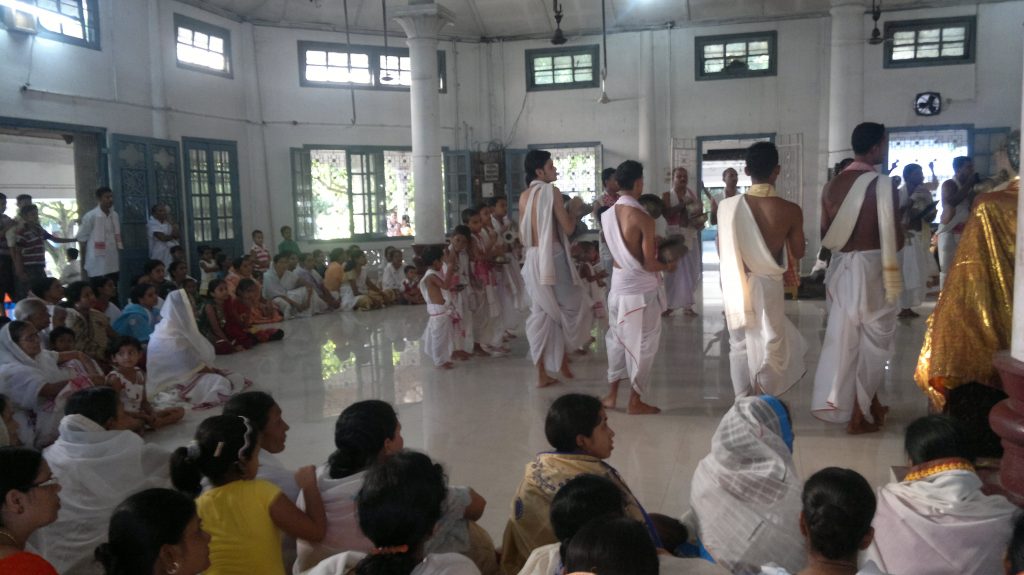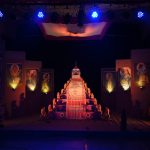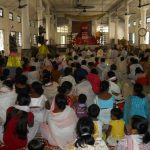Srimanta Sankaradeva was a great polymath, who contributed in numerous disciplines. He created a new religious order named Eka Sharana Nāma Dharma, which had many distinctive features. He was not only a religious leader, but also a poet, playwright, textual critic, musician, actor, director, dancer, choreographer, painter, textile designer and so on. He was even an architect, who designed the unique place of worship Kirttanghar or Nāmghar. It is different from all types of temples in India. It has columns of pillars inside the hall, which too is not seen in most other worshipping places. It was constructed with locally available materials like bamboo, wood, thatch etc unlike the huge stone-made temple structures elsewhere. That made it possible for the followers to dispense with royal patronage, which was very much essential in other religious orders to construct their expensive temples. Apart from these economic and political aspects, there was the environmental aspect too. The vernacular architecture evolved by him was completely sustainable. All the materials used in Kirttanghar or for that matter in any activity within the Thān or Sattra happened to be eco-friendly. Bamboo, wood, thatch etc were all replenishable commodities gathered from nature. So nature was not harmed in the least. This was certainly due to the sensitiveness of Srimanta Sankaradeva to ecological issues. He said in his Kirttana-ghoshā that one tree was equivalent to ten sons. In transcreation of Bhāgavata, he compared the trees with saints. Ito Vrindāvane āsai yata tarugana / Dekhā dekhā kena mahāsādhura lakshana / Karai para upakāra kino kripāmaya / Pararese arthe jivai ito brikshachaya (Bhāgavata 10/926) That means look at the trees in this Vrindavana. They have the attributes of great saints. How compassionately they help people. They live only for the benefit of others.
Srimanta Sankaradeva understood the malaise of the then society very well. A section of the priest community misled the people by misinterpreting the scriptures to suit their own interests. People had no access or knowledge of the scriptures due to illiteracy. Lot of distorted activities took place in the name of deity worship. Since worship with sacrifice was in vogue, even human beings were sacrificed before the deity. The man selected for sacrifice before the deity was called Bhogi. He had liberty to breach modesty of any female within the kingdom. No one had the courage and confidence to stand against these regressive traditions, because they were not literate; the traditional educational institutions Tol were reserved only for the boys from higher castes. Moreover there was no common platform that could be used for undertaking social reform.
The new order founded by Srimanta Sankaradeva had socio-economic factors also in addition to religious ones responsible for its emergence. He did away with the requirement of priests. It was done to redeem the people from the clutch of priests who were mostly extortionists. Moreover he did away with the influence of the Tāntric cult, who sacrificed even human beings. This was also the reason why he dispensed with female deity worship, whereas all other Vaishnavite orders in Sanātana religion had female deity worship. Srimanta Sankaradeva insisted on Eka Sharana or submission to a single entity, dispensing with female deity worship as the decadent practice of the Tāntrics in the name of female deity worship had pushed the society to the nadir. There were at least forty temples in Assam in medieval times, where sacrifices, including human sacrifice were carried out. Srimanta Sankaradeva saved people from all these regressive customs.
Srimanta Sankaradeva differed from other Vaishnavite Gurus even in respect of devotion to lord Krishna. He adopted the Dāsya (servitude) form of devotion among the nine forms of devotion. The form of his devotion was that of servitude towards God. Contrary to that, we find the Madhura (conjugal) form or Vatsalya (affection) form or Sakhitva (friendliness) form of devotion among other Krishna-devotees of Sanātana religion. Srimanta Sankaradeva avoided the Madhura form of devotion very carefully. This form was prevalent among the devotional orders which equated the worshipper and the worshipped. These orders, especially the Sahajiyā cult led to decadence in the society by spreading unwarranted practices. They were devotees only apparently; their activities led to undermining of the status of women, whose honour were frequently breached. So there was a social necessity of highlighting the Dāsya form of devotion instead of Madhura form of devotion. These aspects of Eka Sharana Nāma Dharma prove the reformative nature of Srimanta Sankaradeva. There is ample scope for deducing that the necessity of social reform encouraged him to found a new order. The plethora of reformative advices in the vast body of his writings also prove that.
The elements of reform were more pronounced in his activities than religious theories. He loved people. He was a humanist, albeit with a spiritual thrust. The entire ambience inside the Kirttanghar or Nāmghar is democratic, with equal place for all. There is no differentiation or discrimination in Eka Sharana Nāma Dharma on the basis of caste, sex or nationality. Srimanta Sankaradeva developed this order on the strong foundation of egalitarian principle. This was a revolutionary act in medieval time. That was why Mahatma Gandhi said that the Rāma-Rājya of his dream had already been fulfilled by Srimanta Sankaradeva. In 1922, he wrote in Young India “Assam, indeed, is fortunate for Sankaradeva has, five centuries back, given to Assamese people an ideal which is also my ideal of Rāmarājya.” The evil of untouchability, which was fought against by Mahatma Gandhi throughout his life, had been totally eradicated by Srimanta Sankaradeva in his egalitarian order. Whereas the people of higher castes dominated all spheres of the society including social and religious spheres, he opened the door of his order to all and sundry. Not only that, all devotees had to sit together on the floor of the Kirttanghar or Nāmghar and partake of the offerings to God. Srimanta Sankaradeva’s spiritual follower, Guru Nanak also introduced the Langar system in the Gurudwārā on this principle only. Guru Nanak came to Bardowa in 1505 to meet Srimanta Sankaradeva. The entire system of Sikh religion was derived from Eka Sharana Nāma Dharma.
A notable feature of Kirttanghar or Nāmghar is that the Prasāda or offering to God was unique among all religious orders. Srimanta Sankaradeva saw to it that the devotees could get wholesome, nutritious food, while selecting the ingredients of the offerings. The Prasāda used in his order was wholesome food, rich in protein and other necessary nutritions. It had gram, lentil, coconut, banana etc. Even digestive elements like ginger were added in it. It reflected his concern and empathy for people.
As I said earlier, Srimanta Sankaradeva was a great humanist. Unlike other preceptors, he did not denigrate human birth or human body. Rather he treated it as a perfect tool for elevating oneself. He said, Durlabha manushya janma nakarā biphala/ Chintā mane Mādhavara charana kamala (Kirttana-ghoshā/358) That means one should not waste the precious human life and should rather think about the lotus feet of God.
Srimanta Sankaradeva had sound philosophical base for this importance attached to human life. He said in his transcreation of Bhāgavata,
Tumi Brahma tattva jagata jateka
tomārese krirā bhānda
(Bhāgavata / 3 / 157)
That means you are the supreme entity, Brahma. The entire creation is nothing but your play-field. So the entire creation was manifestation of Brahma for him. This was a great positive attitude. He also said that it was a great fortune to be born as human being in Bhāratavarsha.
Just like Sri Aurobindo (1872-1950) who came four centuries after him, Srimanta Sankaradeva was for integral development of human beings. But while Sri Aurobindo’s perspective was limited to philosophical evolution, Srimanta Sankaradeva’s vision of development included culture too. People were supreme for him. He said once that he treated the ardent devotees themselves as his Guru. We can compare this with the anecdote about Jesus that he washed the feet of his own disciples. Srimanta Sankaradeva also treated ailing people and was an expert in Ayurveda. Once he cured a man suffering from Tuberculosis. He was a married man and he advised his disciples also not to shun the world. He understood the multi-dimensional nature of human beings and hence he never asked his followers to be ascetics. He had five children, but did not bequeath the ownership of his institutions to any of them. He eked out his own living, unlike other preceptors in India or elsewhere. This tradition is followed by the heads of Thān and Sattra in his order till these days. All devotees residing therein have to engage in cultivation work.
Srimanta Sankaradeva reformed the society. He incorporated the content of the then curriculum in his plays and hymns so that the common people could learn the content of formal education even if they did not go to school. He did not keep walls in the place of worship so that the recital could reach even those who did not come inside. He even said it categorically that women and people in the lowest echelon of the society should be educated. He wrote in Nimi Navasiddha Sambāda – Stree shudra antya jāti tāko shikshā dibā māti. (verse 333) That means call the women and people in the lowest echelon and educate them. He even initiated women, an unheard of thing in the medieval time. Khersuti, Kalindi, Barabahi, Chakuli and Chandari were some of them.
Ethics and educational contents constitute a large part of his writings. If we remove the names of the almighty like Krishna, Ram, Hari etc from his writings, it is all ethics. For instance he asked people to shun demonic nature and to show tolerance to people of other beliefs. He was a modern man, I would say the first modern Assamese. He talked about women’s right at a time when women’s honour was violated by the Bhogis. In his transcreation of Uttarākānda Rāmāyana, he came away from the original and put critical remarks against Rama in the mouth of Sita. She said Bolāibo gharani āro Rāghavara ghare/ nāi teve nāri nilājini mota pare (verse 299). That means if I again call myself as wife of Raghava, then there will not be more shameless woman than me. Even his maiden book Harishchandra Upākhyāna had a severe warning against those who treated women badly. Strika durbala kare konano niskhale/ Jvalanta bahnika bāndhe bastrara ānchale (verse 75) That means who is that evil one that makes woman weak, he ties burning fire in knot of cloth. Thus he set the feministic trend in modern Indian literature. Only a humanist would carry out such revolutionary tasks.
Srimanta Sankaradeva had his own religious philosophy. I have named it Vivartanavāda as it facilitates the elevation of the individual self or Jiva from the primary dual state to the non-dual state of identity with universal self or Brahma. Srimanta Sankaradeva gave stress on spiritual evolution of the devotee from gross to subtle, from plurality to non-duality. Evolution is an important theme in his writings. In fact he started his Kirttana-ghoshā with descriptions of the incarnations of Ishwara. These incarnations are nothing but metaphors for different phases of development of the creatures. So Srimanta Sankaradeva highlighted the process of evolution. His philosophy was unique. It synthesized the entire spectrum of Advaitavāda, Dvaitavāda, Vishistādvaitavāda, Dvaitādvaitavāda etc and created a unique philosophy. It accommodated thoughts of all inclinations, elevating the Jiva to the pinnacle of realization of the supreme absolute. One specialty of his philosophy is that he equated Brahma and Ishwara, which was a revolutionary hypothesis. He says this categorically in a verse of his magnum opus Kirttana-ghoshā,
Tumi Paramātmā jagatara Isha eka
Eko bastu nāhike tomāta byatireka
(Kirttana-ghoshā / 519)
That means you are the universal self as well as the one supreme God of the creation. There is nothing else than you.
The Paramātmā or universal self, which is beyond all attributes and the Ishwara, the supreme God, Who is the abode of all virtues are the same. No other branch of Sanātana Indian philosophy had taken this position before Srimanta Sankaradeva. Thus he brought two parallel paths, the path of knowledge Jnāna-mārga and the path of devotion Bhakti-mārga together. Two hundred years after him Spinoza (1632-1677) said the same thing, when he preached love for the absolute being. Thus Srimanta Sankaradeva was a guiding light for Spinoza also.
He said that Ishwara exists in every being and hence one should see every one as manifestation of God. He wrote in Kirttana-ghoshā – Samaste bhutate dekhibeka Nārāyana. (Verse 382) That means one should see lord Narayana in all beings. Thus he lived by the tenet of Mahā-Upanishada, which says Vasudhaiva kutumbakam. That means the entire world is our family. Obvious corollary of it was to shun violence of all types, which he categorically said. He said Hena jāni asura svabhāva save eri / Samasta prānika pujā Vishnu buddhi kari. (Kirttana-ghoshā/359) That means one should give up all demonic nature and worship all creatures by treating them as Vishnu.
Srimanta Sankaradeva forgave even his adversaries. He asked his followers not to hate the non-believers. He taught them tolerance, the most important requisite of a civilized society. He forgave all the priests who took him to the royal courts in two different kingdoms. It may be mentioned that Srimanta Sankaradeva and his followers were continually harassed by the priest community as the new religious order dispensed with the intermediaries, thereby putting livelihood of the priests at stake.
Srimanta Sankaradeva’s vision encompassed the entire humanity, it was not restricted to any geographical region. In one place, he said, Obā naraloka, Hari bhajiyoka, meaning O mankind, worship lord Hari. His altruistic love embraced entire humanity; that is nothing but humanism. He was a global citizen in true sense. This global vision has become all the more relevant today, when the entire humanity have come together to fight a Pandemic COVID19. That one’s fate is linked with that of others has been established in these trying times. It is with Srimanta Sankaradeva’s ideology that we can overcome the intransigence that prevails in many societies. He categorically said that one should not be vindictive to others and rather be compassionate. He wrote in Bhakti-Pradipa, Parara dharmaka nihingsibā kadāchita / Karibā bhuta dāyā sakaruna chitta (verse 141). That means one should not be vindictive to other religions; one should be sympathetic to the creatures with a compassionate heart.
Srimanta Sankaradeva believed in intrinsic goodness of human beings. He forgave all his adversaries. He did not keep any grudge against his prosecutors. When the Ahom king ordered the complainants to take initiation from the saint after hearing a baseless complaint by the priests against Srimanta Sankaradeva, the saint exempted them from that. His compassion extended even to animals and birds. Once during his pilgrimage he released a peacock and a deer from traps laid by a hunter, at the same time compensating the hunter for his losses. He did not approve of the hunter’s action but at the same time had empathy for him. When the hunter came to know about it he realised the truth of life and came near the saint. He paid obeisance to Srimanta Sankaradeva and became a disciple.
Srimanta Sankaradeva was pioneer in the entire world in using cultural tools like plays for proselytizing work. The great German playwright Bertolt Brecht (1898-1956), who used his plays as forum for conveying his leftist and anti-fascist message, came four centuries later. Srimanta Sankaradeva was also the first playwright in all modern Indian languages. He used the language of the common people to convey his message even though he was a great Sanskrit scholar. The Brajāwali language he used in the plays was nothing but the colloquial form of Assamese language. Moreover he used ethnic ingredients in costumes used by the characters of his plays known as Ankiyā plays. He took these ingredients from tribes like Rabha, Tiwa, Mising, Jaintia etc. All his works were targeted at bringing together people of different castes and ethnicity. In his classical dance form known as both Sattriyā Nritya and Sankari Nritya, he took hand and foot movements from tribes like Mising, Karbi, Bodo, Rabha, Dimasa etc. Similarly his music had ingredients from tribes like Ahom, Tiwa, Bodo, Dimasa etc. The literary and cultural contributions by him brought all ethnic groups together, because they found their own heritages reflected in it. The cultural wealth created by Srimanta Sankaradeva became a common heritage for all ethnic groups. He could do this because he loved people. He did it in spite of the fact that most of the tribes believed in animism, not in the religious philosophy preached by him. This showed his magnanimity. He was above narrow sectarianism. Thus he created the modern Assamese society. This is why he is known as father of Assamese society.
Srimanta Sankaradeva created the institution known as Thān or Sattra, the Kirttanghar or Nāmghar being its central component. It may be mentioned here that when set up in villages, it is popularly called Nāmghar and when set up in Thān or Sattra, it is called Kirttanghar. This multi-faceted institution is the fore-runner of community groups like Kibbutz, Commune etc. The strong community life in Assam is a legacy of Srimanta Sankaradeva. The Nāmghar is not for religious functions only, but also for cultural activities and socio-economic activities. Thus the institutional structure of his religion highlighted the emphasis on people rather than theology. It achieved social unity in an unprecedented manner and worked for social welfare. All discussions about the societal activities take place here. The societal disputes have been resolved by most people of Assam over the centuries in the floor of Nāmghar, not in court-rooms. The village life has been regulated from the Nāmghar only. Thus Srimanta Sankaradeva was pioneer in the entire world in local area administration. The seed of Panchāyatirāj was embedded in the structure of Nāmghar. This institution is one of the greatest creations in recent centuries for integrated development of any society.
[Edited version of the lecture delivered in an online programme organised by Naamghar Association of America on 19th July, 2020]




